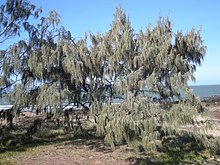Casuarina equisetifolia
| Casuarina equisetifolia | |
|---|---|
 |
|
| C. equisetifolia subsp. incana | |
| Scientific classification | |
| Kingdom: | Plantae |
| (unranked): | Angiosperms |
| (unranked): | Eudicots |
| (unranked): | Rosids |
| Order: | Fagales |
| Family: | Casuarinaceae |
| Genus: | Casuarina |
| Species: | C. equisetifolia |
| Binomial name | |
|
Casuarina equisetifolia L. |
|
| Subspecies | |
|
C. e. subsp. equisetifolia |
|
C. e. subsp. equisetifolia
C. e. subsp. incana
Casuarina equisetifolia or Australian pine tree is a she-oak species of the genus Casuarina. The native range extends from Burma and Vietnam throughout Malaysia east to French Polynesia, New Caledonia, and Vanuatu, and south to Australia (north of Northern Territory, north and east Queensland, and north-eastern New South Wales). Populations are also found in Madagascar, but it is doubtful if this is within the native range of the species. The species has been introduced to the Southern United States and West Africa. It is an invasive species in Florida and South Africa.
Casuarina equisetifolia was officially described by Linnaeus in 1759 as Casuarina equisefolia. A type was designated by New South Wales botanist Lawrie Johnson in 1989. The specific name equisetifolia is derived from the Latin equisetum, meaning "horse hair" (referring to the resemblance of the drooping branchlets to horse tail). Common names include coast sheoak (coast she oak, coastal she-oak), beach casuarina, beach oak, beach sheoak (beach she-oak), whistling tree, horsetail she oak, horsetail beefwood, horsetail tree, Australian pine, ironwood, whistling pine, Filao tree, and agoho.
There are two subspecies:
Casuarina equisetifolia is an evergreen tree growing to 6–35 m (20–115 ft) tall. The foliage consists of slender, much-branched green to grey-green twigs 0.5–1 mm (0.020–0.039 in) diameter, bearing minute scale-leaves in whorls of 6–8. The flowers are produced in small catkin-like inflorescences; the male flowers in simple spikes 0.7–4 cm (0.28–1.57 in) long, the female flowers on short peduncles. Unlike most other species of Casuarina (which are dioecious) it is monoecious, with male and female flowers produced on the same tree. The fruit is an oval woody structure 10–24 mm (0.39–0.94 in) long and 9–13 mm (0.35–0.51 in) in diameter, superficially resembling a conifer cone made up of numerous carpels each containing a single seed with a small wing 6–8 mm (0.24–0.31 in) long.
...
Wikipedia
